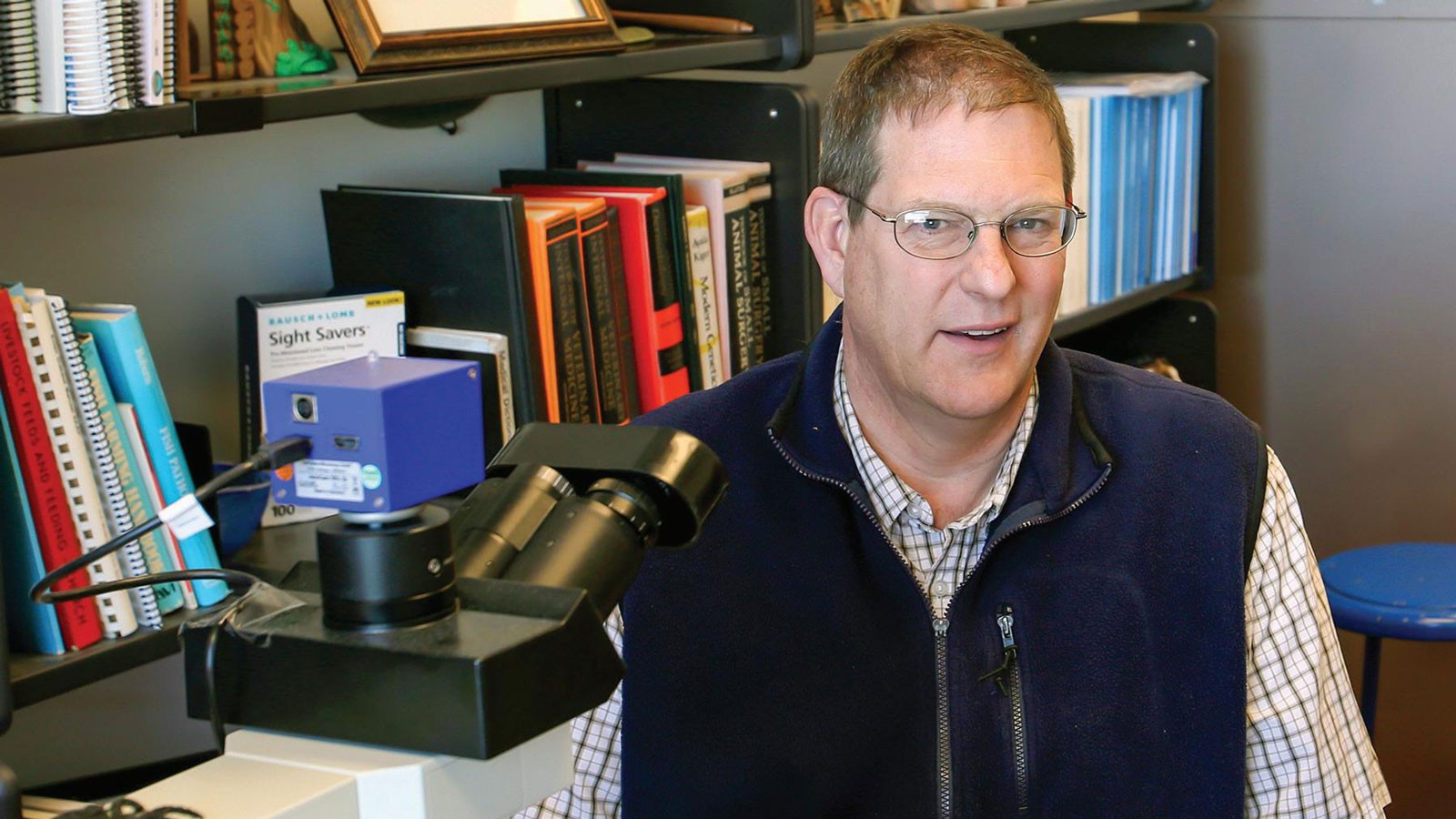Tom Baldwin Receives 6th Award for Teaching Vet Med Students How to Find What Matters
By Ethan Brightbill |
Pathologist Dr. Tom Baldwin teaches in USU's School of Veterinary Medicine and is director of the Utah Veterinary Diagnostic Laboratory.
While Dr. Tom Baldwin was proud to learn that the School of Veterinary Medicine’s Class of 2022 had selected him for his sixth Best Pre-Clinical Teaching Award since 2015, he gave little credit to himself for why students voted for him. Instead, he cited the material used in class as his students’ motivation.
“When we teach our veterinary students,” Baldwin said, “we use real cases that come through the laboratory, that we’ve taken photos of and worked on. Students sense that very quickly.”
Baldwin is director of the Utah Veterinary Diagnostic Laboratory, a cooperative effort between Utah State University and the Utah Department of Agriculture and Food that works to protect the state’s animal and human public health. The UVDL has been involved in everything from determining if plants in a particular pasture can poison animals to understanding how COVID-19 affected farmed mink.
A side benefit of all that work and research is a wealth of examples for students to learn from in Baldwin’s general pathology course.
“What that communicates to students is that the material we’re talking about is important,” Baldwin said. “Otherwise, there wouldn’t be a photograph of it in the first place. When we talk about what an infarct (a localized area of dead tissue caused by loss of blood flow) looks like, we can show them and say here’s an acute one, here’s a chronic one. And it suddenly means more, because it's a real case.”
To illustrate his point, Baldwin pulled up two pictures of a dog’s kidneys — one before death and one after. Students in his class are tasked with determining whether the dog died from a blood clot in its heart that led to kidney damage or if the clot could have happened postmortem.
“Examples like that are the backbone of the course,” Baldwin said. “How important is this stuff? Well, it did this to those kidneys.”
Baldwin developed his course from scratch by taking the most prominent veterinary pathology text and supplementing it with the equivalent text in human medicine. In addition to providing greater medical context, this choice also means that Baldwin can use pictures of human medical conditions in his class. That can make identifying many problems easier — humans don’t have as much hair to obscure things like bruises or lesions — and ensures that Baldwin always has visual examples to work with.
“The problem with depending on random pathology coming into the lab to teach a principle is that you can't place an order for a cow with pneumonia, you know?” joked Baldwin.
Baldwin strives to find materials that students can recognize the importance of in part because of his own experiences as a student. Like other veterinary medicine students, he was astounded by the sheer volume of material he had to absorb. And without guidance on what really mattered, he was overwhelmed.
“I was studying hard one evening during my first year at vet school when the realization came to me,” Baldwin said. “And it was accompanied by a sense of panic. And I had to cope with how I was going to get through that when I couldn’t get through all of the material.”
Baldwin encourages students to identify what matters in a case and worry less about memorizing everything perfectly.
“One of their chief exercises is simply sorting the significant from the less important,” Baldwin said. “None of it is unimportant, but some of it is less important, and so we try and use things that are life-threatening to help them prioritize where to put their efforts, as they’re going to have limited time to work with.”
To describe the situation, Baldwin referred to the final stanza of a poem on the wall of his office, “About Crows” by John Ciardi:
The young crow flies above, below,
And rings around the slow old crow.
What does the fast young crow not know?
— Where to go.
“They're very bright, capable ‘crows,’” Baldwin said, “some of whom are brighter than I am. But they don't know where to go. So we try to put together materials that help them to focus the limited amount of time and energy they have on what matters most.”
WRITER
Ethan Brightbill
Writer and Marketing Assistant
College of Veterinary Medicine
Ethan.Brightbill@usu.edu
CONTACT
Tom Baldwin
Director
Utah Veterinary Diagnostic Laboratory
tom.baldwin@usu.edu
TOPICS
Awards 698stories Faculty 308stories Agriculture 225stories Animals 90stories Vet Sciences 62storiesComments and questions regarding this article may be directed to the contact person listed on this page.







